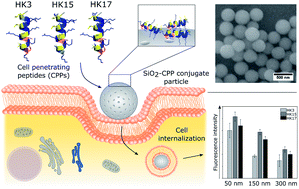当前位置:
X-MOL 学术
›
Nanoscale Adv.
›
论文详情
Our official English website, www.x-mol.net, welcomes your
feedback! (Note: you will need to create a separate account there.)
Interdependence of charge and secondary structure on cellular uptake of cell penetrating peptide functionalized silica nanoparticles
Nanoscale Advances ( IF 4.6 ) Pub Date : 2019/12/09 , DOI: 10.1039/c9na00693a Isabel Gessner 1 , Annika Klimpel 2 , Merlin Klußmann 2 , Ines Neundorf 2 , Sanjay Mathur 1
Nanoscale Advances ( IF 4.6 ) Pub Date : 2019/12/09 , DOI: 10.1039/c9na00693a Isabel Gessner 1 , Annika Klimpel 2 , Merlin Klußmann 2 , Ines Neundorf 2 , Sanjay Mathur 1
Affiliation

|
The capability of cell-penetrating peptides (CPPs) to enable translocation of cargos across biological barriers shows promising pharmaceutical potential for the transport of drug molecules, as well as nanomaterials, into cells. Herein, we report on the optimization of a CPP, namely sC18, in terms of its translocation efficiency and investigate new CPPs regarding their interaction with silica nanoparticles (NPs). First, alanine scanning of sC18 yielded 16 cationic peptides from which two were selected for further studies. Whereas in the first case, a higher positive net charge and enhanced amphipathicity resulted in significantly higher internalization rates than sC18, the second one demonstrated reduced cellular uptake efficiencies and served as a control. We then attached these CPPs to silica nanoparticles of different sizes (50, 150 and 300 nm) via electrostatic interactions and could demonstrate that the secondary alpha-helical structure of the peptides was preserved. Following this, cellular uptake studies using HeLa cells showed that the tested CPP–NPs were successfully translocated into HeLa cells in a size-dependent manner. Moreover, depending on the CPP used, we realized differences in translocation efficiency, which were similar to what we had observed for the free peptides. All in all, we highlight the high potential of sequential fine-tuning of CPPs and provide novel insights into their interplay with inorganic biologically benign nanoparticles. Given the high cellular permeability of CPPs and their ability to translocate into a wide spectrum of cell types, our studies may stimulate future research of CPPs with inorganic nanocarrier surfaces.
中文翻译:

电荷和二级结构对细胞穿透肽功能化二氧化硅纳米粒子细胞摄取的相互依赖性
细胞穿透肽 (CPP) 能够使货物跨生物屏障转运的能力显示出将药物分子和纳米材料转运到细胞中的巨大潜力。在此,我们报告了 CPP(即 sC18)在易位效率方面的优化,并研究了新的 CPP 与二氧化硅纳米粒子 (NPs) 的相互作用。首先,sC18 的丙氨酸扫描产生了 16 个阳离子肽,从中选择了两个用于进一步研究。而在第一种情况下,较高的正净电荷和增强的两亲性导致比 sC18 显着更高的内化率,第二种情况显示细胞摄取效率降低并用作对照。然后,我们将这些 CPP 连接到不同尺寸(50、150 和 300 nm)的二氧化硅纳米粒子上通过静电相互作用,可以证明肽的二级α-螺旋结构得到了保留。在此之后,使用 HeLa 细胞的细胞摄取研究表明,测试的 CPP-NPs 以大小依赖的方式成功转移到 HeLa 细胞中。此外,根据使用的 CPP,我们意识到易位效率的差异,这与我们观察到的游离肽相似。总而言之,我们强调了 CPP 连续微调的巨大潜力,并就它们与无机生物良性纳米粒子的相互作用提供了新的见解。鉴于 CPP 的高细胞渗透性及其转移到多种细胞类型中的能力,我们的研究可能会刺激未来对具有无机纳米载体表面的 CPP 的研究。
更新日期:2020-02-13
中文翻译:

电荷和二级结构对细胞穿透肽功能化二氧化硅纳米粒子细胞摄取的相互依赖性
细胞穿透肽 (CPP) 能够使货物跨生物屏障转运的能力显示出将药物分子和纳米材料转运到细胞中的巨大潜力。在此,我们报告了 CPP(即 sC18)在易位效率方面的优化,并研究了新的 CPP 与二氧化硅纳米粒子 (NPs) 的相互作用。首先,sC18 的丙氨酸扫描产生了 16 个阳离子肽,从中选择了两个用于进一步研究。而在第一种情况下,较高的正净电荷和增强的两亲性导致比 sC18 显着更高的内化率,第二种情况显示细胞摄取效率降低并用作对照。然后,我们将这些 CPP 连接到不同尺寸(50、150 和 300 nm)的二氧化硅纳米粒子上通过静电相互作用,可以证明肽的二级α-螺旋结构得到了保留。在此之后,使用 HeLa 细胞的细胞摄取研究表明,测试的 CPP-NPs 以大小依赖的方式成功转移到 HeLa 细胞中。此外,根据使用的 CPP,我们意识到易位效率的差异,这与我们观察到的游离肽相似。总而言之,我们强调了 CPP 连续微调的巨大潜力,并就它们与无机生物良性纳米粒子的相互作用提供了新的见解。鉴于 CPP 的高细胞渗透性及其转移到多种细胞类型中的能力,我们的研究可能会刺激未来对具有无机纳米载体表面的 CPP 的研究。










































 京公网安备 11010802027423号
京公网安备 11010802027423号